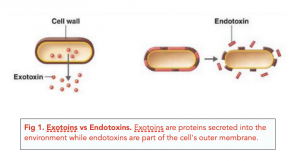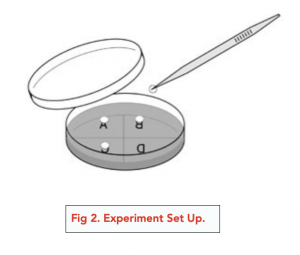Bacteria, Antibiotics, and Other Medicines (A-level Biology)
Bacteria, Antibiotics, and Other Medicines
Bacteria
We have learned in previous tutorials how bacteria can be pathogens that cause disease. We will now look at some specific mechanisms with examples.
- Staphylococci produce exotoxins. Exotoxins are soluble proteins produced by bacteria, as part of their metabolism or during reproduction. They can be highly toxic to the host, disrupting host cell structures or cell metabolism. Staphylococci are an example of a bacteria species that produce exotoxins.
- Salmonella produce endotoxins. Endotoxins are part of the outer cell membrane in gram-negative bacteria. They are lipopolysaccharides (or lipoglycans), and can trigger inflammation and other immune responses, such as fever, in humans. Salmonella are an example of a bacteria species that produce endotoxins.

- Mycobacterium invade host tissues. We have previously covered the pathogenicity of how the TB bacteria cause tuberculosis in humans. Remember that the TB bacteria are able to invade macrophages and lie dormant inside them due to their thick waxy cell walls which protect them from lysozymes, and are able to reinfect the host later.
Antibiotics
- Antibiotics are medicines used against bacterial infection. Antibiotics are able to target specific structures unique to the bacteria e.g. the cell wall, thus, they are effective against the pathogens without causing damage to human cells. The first antibiotic, penicillin, was discovered by Alexander Fleming in 1928.
- There are two main types of antibiotics. Antibiotics may be bacteriostatic, or bactericidal.
- Bacteriostatic antibiotics prevent further growth and replication of the bacteria. Bacteriostatic antibiotics disrupt the bacteria’s protein production, DNA replication, or metabolism, thus stopping the bacteria from growing or reproducing any further. Tetracycline is an example of bacteriostatic antibiotics.
- Bactericidal antibiotics kill the bacteria. Usually by destroying bacterial cell wall, bactericidal antibiotics cause a lethal disruption of the bacteria’s cell structure. Penicillin is an example of this type of antibiotics.
- Widespread use of antibiotics has led to antibiotic resistance. Genetic mutations may occur in a bacteria which makes it resistant to an antibiotic. When the antibiotic is used, it leads to natural selection of the bacteria with the mutation (as all other bacteria without the mutation are affected), resulting in this resistant bacteria being able to reproduce greatly and pass on the mutation. The more antibiotics are used, the more antibiotic-resistant bacteria are able to proliferate. Some examples of these bacteria are:
- Methicillin-resistant Staphylococcus aureus (MRSA). MRSA are a group of gram-positive bacteria that are resistant to antibiotics such as methicillin and oxacillin, which are derivatives of penicillin. They usually cause skin and joint infections.
- Clostridium difficile (C. difficile). C. difficile is a bacteria that infects the gastrointestinal tract. It most commonly affects people who have recently been treated with antibiotics, as the normal commensal bacteria of the digestive system are wiped out by the antibiotics, allowing C. difficile to proliferate and cause an infection.
- Antibiotic resistance is a danger to healthcare. When bacteria become resistant to antibiotics, it makes it much more difficult to treat infections. This is particularly worrying as some infections can be life-threatening, and because infections by antibiotic-resistant bacteria are most common in hospitals where there are ill and elderly patients with weaker immune systems.
- Hospitals now have regulations on antibiotic prescription, and infection prevention and control.
- There is a stricter policy on prescribing antibiotics. Healthcare staff should only prescribe antibiotics for necessary bacterial infections, and patients are encouraged to complete the full course of the antibiotics so that all bacteria are killed off. This lessens the selection pressure and minimises the chance of new resistant strains forming.
- Patients who are identified to have antibiotic-resistant infections are isolated and treated separately. Patients who are found to be infected with antibiotic-resistant strains are isolated in separate rooms where they are treated by staff wearing the appropriate protective equipment. This prevents the chance of the infection being passed onto staff and other patients.
- Strict hand hygiene is practiced amongst all staff. There are infection-control policies in hospital to prevent transmission of infections, such as mandating healthcare staff to wash their hands with soap and water or alcohol-based gels between every patient, and ensuring staff do not wear any item of clothing or jewellery below the elbow (Bare Below the Elbow policy).
Investigating effects of antibiotics
We can investigate the effect of antibiotics against bacteria using an agar plate of bacteria and antibiotic paper discs. As the antibiotic kill the bacteria, there should be an area of clearing around the paper discs, the radius of which we can measure to compare how effective different antibiotics are against the same bacteria.
It is important to work throughout this practical using aseptic techniques to avoid introducing new bacteria into the experiment.
- Wipe down surfaces and work near a lit Bunsen burner. Using a disinfectant, thoroughly wipe down the surface you will be working on. Have a Bunsen burner lit nearby throughout the experiment as the convection currents will keep foreign bacteria away from the culture you will be using.
- Divide the agar plate into four zones. Gather an agar plate that has been seeded with bacteria. Turn the plate over, and using a marker pen, draw a vertical and horizontal line through the middle of the plate so that you divide the plate into four quadrants. Label each quadrant A, B, C, and D.
- Place an antibiotic disc into each quadrant. Sterilise a pair of forceps by passing it through the bunsen burner flame. Use these forceps to pick up a paper disc that has been impregnated by a particular antibiotic. Place it in the middle of quadrant A. Repeat this process (including flaming the forceps) with 3 more paper discs, each impregnated with a different type of antibiotic, and place them in quadrants B, C, and D respectively.


Other Medicines
Possible sources of Other Medicines
- Medicines contain natural compounds derived from different species. Most drugs used for medicinal purposes contain natural compounds that have been obtained from different species of plants, animals, or microorganisms. For example:
- Penicillin is derived from fungus.
- Aspirin contains a natural compound found in willow bark.
- The plant St. John’s Wort can be used as an antidepressant.
- Biodiversity must be protected to help us advance the development of medicines. It is clear that many organisms can contain medicinal compounds, even though we have only discovered a small fraction of them. Thus, it is important that we protect and maintain the degree of biodiversity present around us now, e.g. by preventing deforestation, advocating for environmentally-friendly practices, so that we can continue to discover new medicines. It is possible that we could discover new compounds which could help us treat diseases we currently believe are incurable.
Personalised Medicines and Synthetic Biology
- Personalised medicines are individualised to the patient’s DNA. As genes play a role in how a person responds to a drug, different people may have different reactions to the same type of drug. Thus, rather than prescribing a set type of drug, researchers are now looking into individualising medicines for patients based on their DNA in order to achieve the most optimum treatment.
- Synthetic biology can be used to create artificial biological compounds or redesign organisms for medicinal purposes. Synthetic biology uses genetic engineering and other types of advanced technology to either create new artificial biological compounds (e.g. cells or proteins) or redesign existing organisms to be used for treating diseases. For example:
- New types of T cell receptors has been created which can specifically bind to antigens found on cancer cells.
- Bacteria can be reprogrammed to sense and target cancer cells at various stages of their life cycle.
FAQs
Bacteria are tiny, single-celled microorganisms that can be found in almost every environment on Earth. They play important roles in ecosystems and can also cause diseases in humans and other organisms.
Antibiotics are medicines used to treat bacterial infections. They work by killing bacteria or preventing their growth and spread. Antibiotics do not work against viral infections, such as the common cold or flu.
Antibiotics work by targeting specific processes in bacteria, such as their ability to produce cell walls or proteins. This leads to the death of the bacteria or stops their growth and spread. Different antibiotics target different parts of bacteria and work in different ways, making it important to choose the right antibiotic for a particular infection.
Some common side effects of antibiotics include nausea, vomiting, diarrhea, skin rashes, and yeast infections. Some antibiotics can also interact with other medications and cause additional side effects. It is important to always follow the instructions of a healthcare provider when taking antibiotics.
Antibiotic resistance occurs when bacteria evolve to become resistant to the effects of antibiotics. This means that antibiotics that were once effective against certain bacteria may no longer work, making infections more difficult to treat. Antibiotic resistance can develop when antibiotics are overused or misused.
Alternative medicines for treating bacterial infections include bacteriophages, prebiotics, and probiotics. Bacteriophages are viruses that specifically target and kill bacteria, prebiotics and probiotics support the growth of beneficial bacteria in the gut, helping to prevent infections. These alternative medicines may be used in combination with antibiotics or as an alternative to antibiotics in some cases.
There are several ways to prevent the spread of bacterial infections, including practicing good hygiene, such as washing hands regularly and covering mouth and nose when coughing or sneezing. It is also important to avoid close contact with people who are sick and to clean and disinfect surfaces and objects that are frequently touched. Additionally, getting vaccinated against bacterial diseases can help prevent infections from occurring.






Still got a question? Leave a comment
Leave a comment